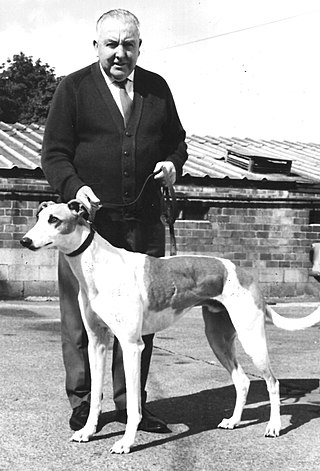Related Research Articles

Mick the Miller was a male brindle greyhound. He is celebrated as the first great racing greyhound to compete in England. Despite a short three-year racing career, his achievements were highly publicised around the world and by the end of his career he had become an icon in the sport. His achievements include winning nineteen races in a row, including the English Greyhound Derby on two successive occasions. He suffered an injury at Wimbledon Stadium whilst racing which broke the streak in 1931, and once recovered was beaten in the attempt to win a third Derby title. He went on to appear in films, and is still considered one of the greatest sporting heroes in the UK.

Wimbledon Stadium, also known as Wimbledon Greyhound Stadium, was a greyhound racing track located in Wimbledon in southwest London, England.
The 1929 Greyhound Derby Final took place on 25 July 1929 at White City Stadium. The winner Mick the Miller received a first prize of £700 in a final with only four runners.

Phil Rees Sr. (1914-1986) was an English greyhound trainer. He was three times British champion trainer and a winner of the English Greyhound Derby.

The 1930 UK & Ireland Greyhound Racing Year was the fifth year of greyhound racing in the United Kingdom and Ireland.
The 1931 UK & Ireland Greyhound Racing Year was the sixth year of greyhound racing in the United Kingdom and Ireland. The total annual attendance across the country for 1931 increased to 17,906,917 from 17,119,120, a fifth consecutive annual increase.
The 1937 UK & Ireland Greyhound Racing Year was the 12th year of greyhound racing in the United Kingdom and Ireland.
The 1945 UK & Ireland Greyhound Racing Year was the 20th year of greyhound racing in the United Kingdom and Ireland.
The 1947 UK & Ireland Greyhound Racing Year was the 22nd year of greyhound racing in the United Kingdom and Ireland.
The 1949 UK & Ireland Greyhound Racing Year was the 24th year of greyhound racing in the United Kingdom and Ireland.
The 1952 UK & Ireland Greyhound Racing Year was the 27th year of greyhound racing in the United Kingdom and Ireland.

The 1953 UK & Ireland Greyhound Racing Year was the 28th year of greyhound racing in the United Kingdom and Ireland.
The 1958 UK & Ireland Greyhound Racing Year was the 32nd year of greyhound racing in the United Kingdom and Ireland.
The 1964 UK & Ireland Greyhound Racing Year was the 38th year of greyhound racing in the United Kingdom and Ireland.

The 1971 UK & Ireland Greyhound Racing Year was the 45th year of greyhound racing in the United Kingdom and Ireland.

The 1973 UK & Ireland Greyhound Racing Year was the 47th year of greyhound racing in the United Kingdom and Ireland.
The 1974 UK & Ireland Greyhound Racing Year was the 48th year of greyhound racing in the United Kingdom and Ireland.

The 1976 UK & Ireland Greyhound Racing Year was the 50th year of greyhound racing in the United Kingdom and Ireland.
The 1977 UK & Ireland Greyhound Racing Year was the 51st year of greyhound racing in the United Kingdom and Ireland.
James Stanley Biss known as Stan (1892–1952) was a leading English greyhound trainer. He was a seven times winner of the Oaks in addition to winning the Scottish Greyhound Derby and Welsh Greyhound Derby.
References
- ↑ "Particulars of Licensed Tracks". Licensing Authorities. 1929.
- 1 2 3 4 Tanner, Michael (2004). The Legend of Mick the Miller: Sporting Icon of the Depression. Newbury: Highdown. ISBN 978-1-904317-67-8.
- 1 2 Dack, Barrie (1990). Greyhound Derby, the first 60 years. Ringpress Books. pp. 57–58. ISBN 0-948955-36-8.
- 1 2 3 4 5 6 7 Genders, Roy (1975). The Greyhound and Racing Greyhound. Page Brothers (Norwich). ISBN 0-85020-0474.
- 1 2 3 4 5 6 7 Genders, Roy (1981). The Encyclopedia of Greyhound Racing. Pelham Books Ltd. ISBN 07207-1106-1.
- ↑ Culpepper Clarke, Carlo F (1934). Greyhound and Greyhound Racing. Methuen & Co Ltd (London).
- ↑ Ash, Edward C (1933). The Book of the Greyhound. Hutchinson & Co. Ltd (London).
- 1 2 3 4 Genders, Roy (1990). NGRC book of Greyhound Racing. Pelham Books Ltd. ISBN 0-7207-1804-X.
- ↑ "Greyhound Racing, International Derby, Mick the Miller wins" . The Scotsman. 21 October 1929. Retrieved 8 December 2024– via British Newspaper Archive.
- ↑ "Remember When". Greyhound Star. 1929.
- ↑ "Birmingham Dog's win" . Birmingham Daily Gazette. 30 August 1929. Retrieved 30 November 2024– via British Newspaper Archive.
- ↑ Barnes, Julia (1988). Daily Mirror Greyhound Fact File. Ringpress Books. ISBN 0-948955-15-5.